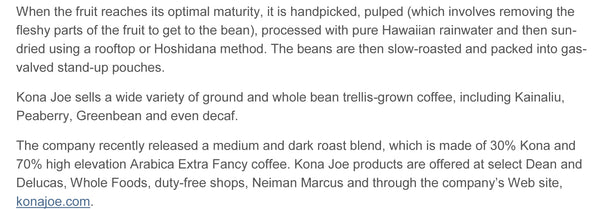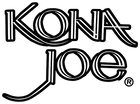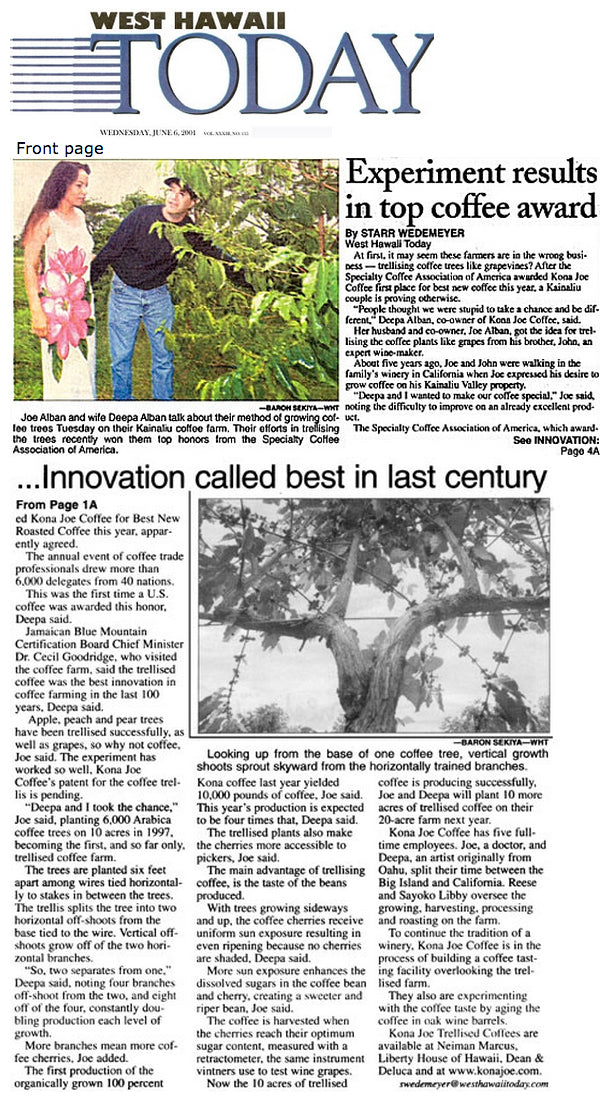Press
Kona Joe Coffee Trellis Makes History

It was clear from the history of coffee how wine and coffee are both specialty beverages and according to Ted Lingle "the future of coffee will follow the wine model".
Kona Joe has been a pioneer constantly working to produce and grow coffee like wine. Growing coffee on a trellis like wine grapes marks the first time in history, coffee has been cultivated like wine. Kona Joe not only cultivates coffee like wine he has recognized the importance of appellation, terroir, and the critical balance of sugars and acids in developing coffee fruit.
Kona Joe acted as a technical advisor to the History channel and the Kona Joe Coffee Trellis will forever be a part of coffee history.
Click Here to see us on Modern Marvels.
For over a decade, MODERN MARVELS has brought grand stories to life.
The complete story of the world’s most popular beverage--and the multi-billion dollar industry behind it.
The ultimate celebration and investigation of engineering excellence.
Elaborating ingenuity, invention and imagination brought to life on a grand scale, MODERN MARVELS® tells the fascinating stories of the doers, dreamers and sometime-schemers who created everyday items, technological breakthroughs and man-made wonders.
COFFEE traces the origins of this tasty drink from Ethiopia over 1,000 years ago to the espresso-fueled explosion of specialty coffee stores like Starbucks. Along the way, we'll see how American companies like Hills Brothers, Maxwell House and Folgers grew to be giants. Discover how billions of coffee beans make their journey from farms and plantations to cups all over the world. And get tips on how to brew a better cup at home!
Los Angeles Magazine

Orthopedics Today
October 2006



West Hawaii Today
June 2001
Business Week Magazine

Kona Joe Coffee
Kona, HI
Deepa and Joe Alban on their 20-acre Kona coffee plantation in Hawaii. Joe devised a patented method of growing coffeetrees using trellises. This lets the coffee cherry, containing the seeds commonly known as beans, ripen more evenly, giving the coffee richer flavor and improved texture.
- Who: Joe Alban, 45, and Deepa Alban, 40
- Revenues: $525,000
- Employees: 11
- Old Job: Joe is an orthopedic surgeon and still practices part-time. Deepa is an artist
- How it Started: As family and friends requested coffee from the Albans' personal stash, they kept planting more
- Preparation: Got help from the Agriculture Dept. and joined trade groups such as the Specialty Coffee Assn.
- Initial Investment: $50,000
- Began In: 1997
- Broke Even: 2000
- Favorite Thing About Kona Joe: "Creating something that makes people say, 'Wow, that really tastes good.'"
- Biggest Challenge: Competing with companies that don't believe in truth in labeling
Orange County Register

He was an O.C. doctor on a Hawaiian vacation. A woman and a bean changed everything.
By GARY A. WARNER / The Orange County Register
Like a benign Dr. Jekyll and Mr. Hyde, Joe Alban has a split personality.
He can be Dr. Alban, a respected orthopedic specialist in surgical whites who fixes all those tendons and bones that accident of birth, car crashes and over-40 basketball leagues send his way.
But then he peels off the medical coat and disappears up the flank of the world's largest volcano. There he reappears in an Aloha shirt as Kona Joe, tropical coffee baron.
I recently drove 1,500 feet up the side of Mauna Loa to find the guy whose life so happily derailed. How a career turned into a sideline. How a hobby became an obsession. How the obsession made Kona Joe, man and product, stars in the small but intense world of coffee growing.
I found Joe Alban in the roasting house, sniffing handfuls of beans while sipping coffee - one of the eight or so cups he has a day.
"It wouldn't be right for people to visit and hear me say, 'No thanks, I've had enough coffee,'" he says.
We wander his 20-acre plantation and I put to him, old school, the basic journalism questions: who, when, what, where and why.
Who: Joe and Deepa Alban. Joe: Doctor. Raised in Long Beach. Lived in Seal Beach. Medical practice in Los Alamitos alongside his father, Dr. Seymour Alban. Deepa: Born in Bora Bora in French Polynesia. Raised on Oahu. Moved to the Big Island of Hawaii. Worked as an artist and in the tourist trade.
When: Hawaii, and then coffee, took over two lives. It's 1986. Joe's on vacation on the Big Island. Deepa is strolling the beach. They meet. They date. They fall in love. They marry in 1990. How to build a life together on their beloved Big Island? They buy 24 acres of land on the slopes of Mauna Loa in 1994 as an investment. Maybe for retirement, a long way down the line. They give 4 acres to a local church. In 1997, they start producing Kona Joe coffee. The brand takes off. It wins awards. It's sold at Hilo Hattie. Then Neiman Marcus on the mainland. The sideline becomes the center of their lives. Today, Joe Alban is semi-retired from the bone business. More Kona Joe than Dr. Joe.
What: Kona Coffee. Not the 10 percent Kona blend stuff you can pick up at the Honolulu airport. The real thing. One hundred percent Kona. Joe's brother, John, runs Alban Vineyards in Arroyo Grande, near Pismo Beach on the central coast. On a visit, Joe became intrigued by the trellises used for the grapes of the winery's Rh'ne varieties. What if he took the same approach to coffee? Joe Alban tried the technique, then had it patented. It turns out an amazingly sweet bean that rocketed Kona Joe to the top of the list of top-end, pure Kona growers on the Big Island. As if the coffee wasn't enough, Joe and Deepa have wrapped their famous beans in chocolate, combining two great American addictions: caffeine and sugar. Called JammerS, a handful are like a sweet espresso jolt in a bag.
Where: Hawaii. The Big Island. The dormant Mauna Loa volcano. The violent geological eons have created a place of intense sun, occasional fog, cooling breezes, good rainfall and amazing soil. It is the premier place to grow coffee in the United States.
As Kona Joe's fame has spread, more visitors have made the twisting drive up to the plantation at Kealakekua. Joe's usually out in the fields or in the roasting house. Deepa is the warm presence in the small visitor's center, café and gift shop. Along with the coffee, JammerS and pieces of Deepa's beautiful Polynesian-themed art, the shop sells that ultimate sign of Hawaiian tourism success: the T-shirt. The black and green Kona Joe shirt is, like the coffee, a quality product.
Why: Passion. A couple's passion for each other. Their passion to make a life in Hawaii, the verdant tropical world they adore. Joe's passion to add to the luster of the already legendary Kona Coffee. Deepa's passion to bring the spirit of aloha to the little parcel on Mauna Loa. "People are just naturally more friendly here," she says. Kona Joe's coffee will give you a buzz. But the sweeping views from the plantation café down to the endless Pacific, the cooling trade winds and friendly voices put you in that exalted state: alert and relaxed.
"I know that some people say they couldn't live here on an island in the Pacific all the time, that they would get what we call rock fever," Joe Alban says, heading off into his plants. "But we love it."
Contact the writer: Warner can be reached at gettingaway@ocregister.com
American Association of Orthopedic Surgeons







